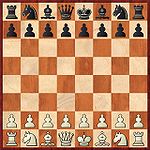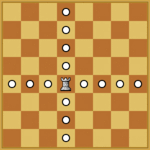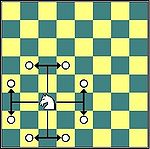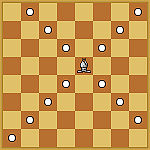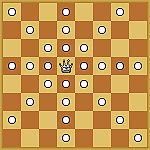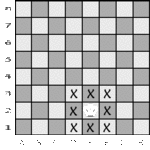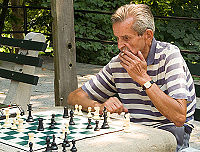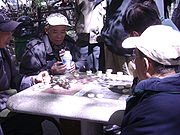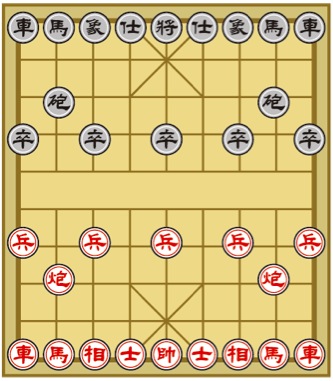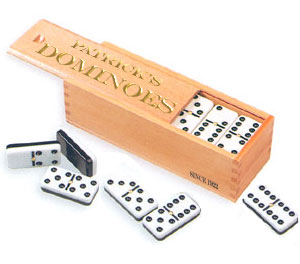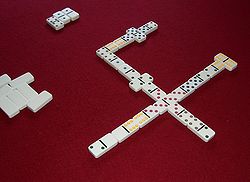From The Peopling of New York City
Contents |
Chess
Background
by Jordanna Winfield
Chess as we know it, Western Chess, began evolving 1500 years ago in the 6th century. Before the game evolved to what it is today, people from India started playing an earlier form of chess. It then spread to Persia, the Muslim world, and finally to Southern Europe. In the 15th century the game evolved to the game we play today.
During the mid 19th century tournaments, like the ones we have now, began. In fact, 1886 was the first time that the world chess championship occurred. In the 20th century the World Chess Federation (FIDE) was established. Now, in the 21st century, we can even play chess online.
In India:
The game began in the 6th century and was called chaturanga, which means “having four limbs,” alluding to the “four divisions [of the military].” Their pieces were called the infantry, present day pawn; cavalry, present day knight; elephantry, present day bishop; and chariotry, present day rook.” (Wikipedia)
In Persia:
In around 600 BCE the Persians started calling chaturanga chatrang. In Persia, further chess terms were developed. Present day “check mate” was invented. However, back them it was called “Shah mat!” which is Persian for “the king is finished.” One would call “Shah mat!” when the king was under attack and could not do anything to be saved. The Persians also invented present day “check,” which they called “Shah!” This is Persian for the word "king." This implied that the king was under attack; however, there are moves that the king, or other pieces, can take in order to save the king.
After the Islamic conquest of Persia, in 644-651 BCE, chess began to spread to the Muslim world. For the most part, the Muslims maintained the Persian vernacular. It actually worked out quite well because in Arabic, “mata” or “mat” means “is dead” or “died.” However, the Muslims changed the name to shatranj. In addition to being able to win by achieving checkmate, when there is no place left for the king to go, you can also win by a stalemate, which occurs when you take all of your opponent’s pieces except for the king.
Chess started spreading around the world. The game was the same; the name was different.
1. Shaterej in North Africa, by the Moors.
2. Acedrex, axedrez, and ajedrez in Spanish.
3. Xadrez in Portuguese.
4. Zatrikon in Greek.
In the rest of Europe variations of the Persian word for king, “Shah” was used.
1. Sah in Romanian.
2. Sah in Slovene.
3. Schach in German.
4. Schaken in Dutch.
5. Shakki in Finnish.
6. Szachy in Polish.
7. Scacchi in Italian.
8. Sahs in Latvian.
9. Skak in Danish.
10. Sjakk in Norwegian.
11. Schack in Sweedish.
12. Escacs in Catalan.
13. Echecs in French.
Chess then spread to the Middle East, as well as to Russia where it was called shakhmaty. (Which sounds very similar to “Shah mat!”)
In early chess the pieces moved as follows -- look below to see the movement of the modern day pieces: (Wikipedia)
1. The King moved the same as it does now.
2. The Queen only moved one square diagonally.
3. The Bishop:
a. In India: two squares either sideways or front and back. You are allowed to jump over a piece in between.
b. In Persia: two squares diagonally. You are allowed to jump over a piece in between.
c. In Southeast Asia: Either one square diagonally or one square forward.
4. The Knight moved the same as now.
5. The Rook moved the same as now.
6. The Pawn only moves one square forwards or diagonally forwards.
Interestingly enough, the Queen and the Bishop weren’t always the strong pieces that they are now. In 1475-1500 the movement of the Queen and the Bishop began to expand. This form began being called “Queens Chess” or “Mad Queen Chess” in various languages including: Spanish, Portuguese, Italian, and French. This made players capable of winning in less moves and accentuated the importance of the moves of the pawns. These new rules spread quickly throughout chess playing places.
In 1834, competitive chess began. In 1851, players started creating new rules dealing with time limits. People were taking as long as two hours to make one move. Thus, five-minute chess was born and rules such as thirty moves in two hours were created.
How To Play
by Max Rybakov
The goal of chess is to checkmate or threaten your opponent's king piece. Each game begins with each player having 16 pieces consisting of, a king, a queen, two bishops, two rooks, two knights, and eight pawns. Arranged as shown in the following image.
The Different Pieces
Each of the different pieces has its own unique way of moving across the board.
The Pawn can only move one space at a time. It can only move forward, but it cannot attack the space in front of it. Instead it can only attack the two spaces that are diagonally in front of it, one on the left and the other on the right.
The Rook can move as many spaces as it can before hitting another piece. It can move either vertically or horizontally and unlike the pawn, it can attack the opponent's pieces the same way.
The Knight moves differently from the other chess pieces because instead of moving on one axis, it moves on two. The Knight starts its move by moving two space along either of its axis (vertical or horizontal but not the diagonal) and then one space in either direction along the other axis.
This Bishop moves only along its diagonal axis. It can move as many spaces as it wants until it hits another piece.
The Queen is traditionally thought of as the most powerful piece in chess. It can move as a combination of the Rook and Bishop, giving it the ability to move as many spaces as it wants along its, vertical, horizontal, or diagonal axis, until it hits another piece.
The King is the most important piece in Chess. Once it has been "mated" the game is over. However, it is very limited in how it can move. It too can move like the queen but only one space in any direction.
The Culture of Chess
In Eastern European Culture
In Eastern Europe, chess is viewed as a test of a person's mental capacities. A chess player in one of these countries is proud of his skill. In many of the former Soviet Republics, chess was viewed almost as a sport would be, with each player being ranked and then competing among peers of his own level and gradually advancing in skill.
A common trend that came out of Eastern Europe is the idea of the "in family" chess teacher. It is a common occurrence that at least one member of a person's relatively near family is familiar with the game and goes on to teach the children as they grow up. This is the most common way to learn the game in these countries; through family games with a grandfather or a father, who would throughout the years pass on their knowledge of the game to their children and grandchildren.
The game has also followed these people as they immigrated to America. It is a very common sight to see elderly Russian or Ukrainian immigrants playing chess in Brighton Beach. America has not changed the game itself, but has in a sense, altered it's value. Second generation immigrants are more Americanized and so are not as familiar with the game and it's value. Even though some of them are still taught by their parents, it doesn't carry the same weight as it would in the home country. However, the elderly still retain their knowledge and also use the game as a gathering point, where they can pass their time while still challenging each others mental faculties. In a sense, chess has actually become more important for elderly "Slavic" immigrants here, than it has been in their country of origin because of a need for such an outlet to socialize and feel connected to others who come from the same place and share the same experiences as they do. As such, games serve mainly as a backdrop for conservation among this group. Walking by such a game an observer might hear playful banter, loud and obnoxious trash talk, and accusations of perpetual cheating, or just talks about the well being of relatives.
Chess in New York City
Demographics
Western style chess is truly a game without borders. In America today, there are many people from completely different backgrounds who play chess. This is large part due to the structure of American immigration. America began as a refuge for immigrants from Western Europe. European immigrants represented the largest group of immigrants dating back to America's founding; only overtaken by Asian immigrants in the 1980's. As such, these people had a great impact on the culture that eventually became "American." They brought with them bits and pieces of their culture, including the game of chess.
Today we live in a world that is many generations removed from the founders of America. Yet they, and the people who came after them, created the world we live in now. Chess has become a large part of that culture. Today whether or not a person will learn the game of chess is not solely determined by the their ethnic background, but more by the person himself. Chess has become a readily available part of American culture and so, if someone wants to, they can learn. Recently I went to Chess NYC, a chess school located in the West Village and was very surprised at the diversity that i saw there. After talking to some of the players there, I quickly realized that chess has truly become an American tradition. Luis Mendoza was a second generation immigrant from the Dominican Republic and he had learned to play from his grandfather as a child. The same was true of Paul Miley, a New Yorker who joked that his family had been here "ever since the revolutionary war, and probably even before that."
Some immigrant cultures favor chess, while some don't as strongly, yet in New York City, chess has become such a staple of the American culture that it doesn't matter where you are from, someone from your community plays chess.
Sources:
"Historical Census Statistics on the Foreign-born Population of the United States: 1850-1990." Census. US Gov, February 1999 . Web. 9 May 2010. <http://www.census.gov/population/www/documentation/twps0029/twps0029.html>.
Brighton Beach Chess
Brighton Beach is currently home to a large population of first and second generation immigrants from the former Soviet Union. Together these people gathered in this area that became known as Little Odessa, named after the city in present day Ukraine from which many of the immigrants came. The name also comes from the uniquely Russian feel that the area brings with it. The shops along Brighton Beach Avenue are littered with Russian stores and restaurants, all of which have more Russian writing on them than English. This is an area where the immigrants have done their best to keep their culture alive, and one part of that culture is chess.
A block away from Brighton Beach Avenue is Seaside Park, a place well known around the area for its concerts and playground, but also for the chess that people play there. Though not usually very crowded before the summer months, Seaside Park has its resident population of chess players who stay all year round. These people are mainly elderly Russian immigrants who learned the game of chess back in the Soviet Union and brought it here, where it reminds them of the life that they left behind. When asked how long they have been playing this game, a common answer was "since childhood," or "I grew up with chess, either in school or at home." In Russia, chess is a popular game and a large part of the population knows how to play. Oleg Semonov from Moscow, who is about 70 years old, said that, "My wife always asks me why I always go out, even when its cold to play. I always answer her that even though my opponents there aren't very good (glancing over at his recently beaten opponent Alex Melnekov who just muttered under his breath 'you got lucky'), I've been playing ever since college so why would I give it up now."
Chess for the elderly Russian population of Brighton Beach symbolizes a way to keep the mind sharp, as well as just something to help pass the time. Alex Melnekov, from Sevastopol, also around 70 years old, said, "It used to be that my family took up most of my time. Either I was at work or just doing something else I was always busy. Now we came to America and I quickly realized that my family had moved, split a little bit more than I would have liked. So I play chess." It turns out that the two had been friends ever since coming to America, and chess was part of their weekly ritual . This is a common occurrence in Brighton Beach, and though not everyone plays several times a week or even at all, it is still a very popular way to spend your day, and test your mind against someone else.
Chinese Chess (象棋)
By
Mei Yu Chen
James Zhang
Claudia Ho
Yeena Wu
Columbus Park is located between Baxter and Mulberry Street at 67 Mulberry Street. It is located in Chinatown.
Columbus Park has a section that is designated for Chinese senior citizens to sit on benches or play games. The most popular game in the park amongst the elderly Chinese immigrants is Chinese chess. It is similar to the more familiar Western-style chess in that it is a game of strategy that requires game pieces with different roles and the need to think ahead of your opponent. However, Chinese chess is unique in its own history, rules, and what it signifies to Chinese immigrants living in Chinatown.
History of Chinese Chess
Chinese chess has a very long history, and a debatable one at that. The origins of Chinese chess have not been confirmed, as it goes so far back in history. There are several stories and versions of Chinese chess's history, but none have been confirmed. However, from its rules and the origins of its Chinese name (Xiangqi) it is commonly believed to have started as a military tactic exercise that gradually evolved into a game.
China had four traditional arts: qin for music, hua for painting, shu for calligraphy, and qi for strategy games. The "qi" in Xiangqi stands for a type of strategy game, which further supports its possible militaristic origins. Many believed that Chinese generals would use a chess-like game to train their army, which is why the game is centered around the idea of war, getting to your opponent's territory, and taking their king or general. This military exercise later evolved into more modern "game" versions which were played by both rich and poor in China, ultimately leading to the Chinese chess we have now.
sources: http://www.chinaculture.org/gb/en_chinaway/2003-12/31/content_44528.htm
How To Play
Chinese chess is a two-player game. It includes a board and 32 pieces; each piece is assigned a role. The board is 9 lines wide by 10 lines long. The pieces are played on the intersections, which are known as points. The vertical lines are known as files, while the horizontal lines are known as ranks. The square marked with diagonal lines on each side of the board is each player’s “palace” or “fortress” which restricts the opponent’s movements. Dividing the two opposing sides (between the fifth and sixth ranks) is the “river.” Although the river provides a visual division between the two sides, only a few pieces are affected by its presence: "soldier" pieces have an enhanced move after crossing the river, while "elephant" pieces cannot cross. There are seven roles: general, guard, elephant, horse, chariot, cannon, and soldier. More about the chess pieces will be explained in the "How to Play" section. Chinese chess is designed like a “war” or “battle.” Two armies advance into enemy territory on the board using strategic moves. Movements of the chess pieces are restricted by their roles and by the “river” and “palace” on the board. The goal is to “capture” your opponent’s general.
Game Pieces
Equipment
The park has some tables with chess boards carved on them for the public to use. However, when the park gets crowded with chess players, some of the players also bring their own chess boards. There are paper ones which usually come with a set of chess. Some people also bring in hand drawn chess boards. The most important part of the board are the lines and the river. Although the park supplies chess boards, the players must bring their own chess pieces. For those who are interested in obtaining chess pieces, most of the book stores around the area sell it. The price usually ranges from $5- $20, but it can also go up to $100 or more. The following are some pictures taken in the park of the various boards that they use. Click on the pictures to see a larger version of the chess board.
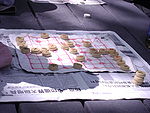
| 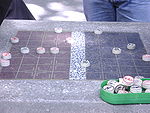
| 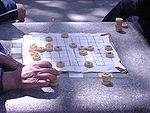
|
| Hand drawn chess board | Chess board at the park | Another chess board |
The generals are labeled with either the traditional Chinese character 將 (pronounced jiang) or 将 in simplified Chinese on the black side and 帥 / 帅 (pronounced shuai, meaning marshal) on the red side. Legend has it that originally the pieces were known as emperors, but when an emperor of China heard about the game, he executed two players for "killing" or "capturing" the emperor piece. After that, players called them generals instead. The general starts the game at the midpoint of the back edge (within the palace). The general may move one point either vertically or horizontally, but not diagonally. A general cannot move into a file which is occupied by the enemy general unless there is at least one piece positioned between the generals in the file. A special rule is that the general may not leave the palace.
The advisors (also known as guards or ministers, and less commonly as assistants, mandarins, or warriors) are labelled 士 (shì) ("scholar", "gentleman", "officer") for black and 仕 shì ("scholar", "official") for red. The advisors start to the sides of the general. They move one point diagonally and may not leave the palace, which confines them to five points on the board. They serve to protect the general. In western chess, this would be similar to the Queen chess pieces.
video demonstration for the generals and the guards
The elephants are labeled 象 (xiàng, meaning elephant) for black and 相 (xiàng, meaning minister) for red. They are located next to the advisors. These pieces move exactly two points diagonally and may not jump over intervening pieces. If an elephant is blocked by an intervening piece, it is known as "blocking the elephant's eye." They may not cross the river and are usually used for defense moves.
video demonstration
The horses are labeled 馬 (mǎ) for black and 傌 (mà). Some traditional sets use 馬 for both colors. They begin the game next to the elephants. A horse moves one point vertically or horizontally and then one point diagonally away from its former position. The horse does not jump as the knight does in Western chess. A blocked horse is also known as "hobbling the horse's leg."
video demonstration
The chariots are labeled 車 for black and 俥 (jū) for red. Some traditional sets use 車 for both colors. The chariot moves and captures vertically and horizontally any distance, and may not jump over intervening pieces. The chariots begin the game on the points at the corners of the board. The chariot is considered to be the strongest piece in the game.
video demonstration
The cannons are labelled 砲 (pào) for black and 炮 (pào) for red. Each player has two cannons. The cannons start on the row behind the soldiers, two points in front of the horses. Cannons move like the chariots, horizontally and vertically, but capture by jumping exactly one piece (whether it is friendly or enemy) over to its target. There must be one piece (the “cannon platform”) between the cannon and the piece it wants to capture. The number of spaces between the cannon and the platform doesn’t matter, whether its 5 spaces or 0 spaces. When capturing, the cannon is moved to the point of the captured piece. The cannon may not jump over intervening pieces if not capturing another piece.
video demonstration
Each side has five soldiers, labeled 卒 (zú, meaning pawn/private) for black and 兵 (bīng, meaning soldier) for red. Soldiers are placed on alternating points, one row back from the edge of the river. They move and capture by advancing one point vertically. Once they have crossed the river, they may also move (and capture) one point horizontally. Soldiers cannot move backward, and therefore cannot retreat; however, they may move sideways at the enemy's edge (meaning, only after they have crossed the river into opponent’s board).
video demonstration
"source: http://www.chinaculture.org/gb/en_chinaway/2003-12/31/content_44528.htm"
Blind Chess/Dark Chess
Another popular form of Chinese Chess is "暗棋" or sometimes called “盲棋", which literally translate to "dark chess" and "blind chess", respectively. It is often played as opposed to the regular game because it requires a shorter amount of time. It also does not require that much thinking, since all the moves are simpler than they are in regular games. Unlike the way regular chess is played, dark chess takes up only half of the chessboard. All of the pieces are covered and place within the square, instead of on the intersecting points of the line. The game starts with the first person uncovering any one of the pieces on the board. The person will assume the color of that piece for the rest of the game. The opponent will take on the opposite color. For the most part, the function of each piece is greatly reduced. For example, "馬", or the horse piece, can only move one space at the time, instead of several intersections like the regular chess. “炮“ or "cannon" is one of the few pieces that retains its function. The basic rules that the game follows are pretty simple.Any piece greater than or equal to another piece, can capture that other piece. “帥“ and “將“, also known as the "general", is one of the most powerful pieces in the game and can capture any piece, except “兵“ or “卒“, also known as the soldiers. The soldiers and the cannon, however, are at the same level and cannot capture each other unless the soldier can be captured through the cannon's jump move, which is having exactly one piece right next to the cannon in the direction of its target.
The dark chess has a greater element of luck involved than the regular form of Chinese Chess, since all of the chess pieces are covered. If the "general" is right next to the "soldier", then the "soldier" can capture the "general" when it is revealed. Unlike regular chess where the "general" has to be checkmated, the dark chess can continue to function without a general. A person can win the game even if he or she lost his or her general. To win the game, one must capture all of the opponent's pieces. One of the common strategies to end the game is to force the pieces into corners where they cannot make any moves, which essentially is like capturing all the opponent's pieces; the last step is just not carried out yet.
There is also another variation of this game, in which the pieces can capture others without the target piece being turned over. This type of move is called "暗吃". In this scenario, the cannon, for example, can jump on another target in the same move if the target happens to be of an opposite color. If the target piece happens to be the same color, then the original piece, in this case the "cannon", would have to retreat back to its previous position. Pieces other than cannon can also perform the same task. However, if the target piece is more powerful than the piece that it is capturing, then the piece that it is capturing would have to retreat, too.
An interviewee mentioned that dark chess is sometimes played at the park, although very rarely. One of the professional chess player interviewees is known for playing that type of chess. Some people believe that truly skillful Chinese chess players can win in dark chess, even when their luck is bad. It takes someone with experience and skills to overturn the tides.
video demonstration
Chinese Chess in New York City
Culture of the Chess Players in the Park
Hey James I fixed this section for you I have some comments I hope you read this through and let me know if you have any questions or problems-Sophie Chinese Chess is an important leisure activity for the immigrants who go to Columbus Park. Some of the chess players live in the park's neighborhood, some are there because they have time to spend after sending their grandchildren to school, and some of them even travel from 8th Avenue or Bensonhurst. The general Chess-playing community is passionate about the game. Some players are so passionate about Chinese Chess that they will come to the park despite the bad weather. They are even willing to play Chinese Chess on the floor of the center building (the center building) on rainy days.
According to a well-known Chinese proverb, “觀棋不語真君子”, gentlemen are not supposed to comment on the games. This proverb sometimes can also be found on the board. However, that is obviously not the case for some players. The observers would yell loudly on the moves the players made; and they do not hesitate to suggest moves to the players. Some even move the pieces and demonstrate the subsequent possible moves. Our interviewee told us that this shows their passion in Chinese Chess, as they were easily excited by the change in the games. There seems to be a cultural difference between western chess and Chinese chess. An interviewee describes this behavior as a "neighborhood cultural activity".
Some, however, are not happy when they are assisted in this fashion. For example, a female Caucasian interviewee mentioned that she believes this form of assistance hinders her learning. She also believes this behavior prevents her from learning through her own mistakes, which also does not provide her with enough time to think about the move. When the interviewee was asked whether she was aware of the aforementioned proverb, she was able to recall the proverb without any assistance. She thinks most people do not follow that and jokingly said that she should get a plaque with the proverb carved on it.
The problem with commenting is not present with the "players of higher league"-James this sounds kind of weird, maybe change it to "The problem with intrusive commenting is not present in highly skilled players"-this is just a suggestion-Sophie. The highly skilled players seem to be more serious with their games. Although the skilled players often attract a larger crowd, nobody from the crowd would make a single comment on the moves. It was interesting to see a small group of observers argue about moves on one side, but the larger crowd, which has about 20 people surrounding 2 chess players, would not speak a single word during the game.
The players in Columbus Park would occasionally play chess for money. They do not really consider playing chess for money as gambling. They see as "a game with prices". The amount varies and ranges from 5 dollars to 100 dollars per game. Commenting on a match for money is prohibited. If an observer makes a comment that's advantageous to Player A, the observer has to pay for the match if Player B loses, even if the comment made little contribution to Player A's victory. Gambling for money is a behavior that can also be observed overseas. According to the laws in Taiwan, a transfer of money grounded on the results of Chinese chess games qualifies as gambling and is illegal. There was a case on April 20th, 2010, when four elderly men whose age totaled up to 300 were brought back to the police station for interrogation, even though the amount of money involved was minimal (approximately $6).[1]
Generally speaking, chess players are not supposed to un-do(do you mean change or take-back) their moves. This courtesy is practiced by most players. However, chess-playing is a leisure activity after all, so some of them are not very uptight about it. The chess players can be very serious if they play games for money. We've witnessed a match in which they played for money during our visit; the players were extremely cautious with their moves, and they never touch the pieces again once they let go of them. (Hey James-what about "they were not to change their mind once they placed their piece down, which made them extremely cautious with their moves".)
Mei Yu: Rhianna, I clicked on the picture. I think this is a picture of women playing cards in the park, and not Chinese chess
Demographics
A majority of the people in the park are Chinese, mainly because the park is located in the middle of Chinatown. However, one interviewee said that sometimes, white people come and watch the game. One time, one of them even played the game! Slowly, New Yorkers are finding out about this fascinating game and playing with the game’s original culture. It is quite fascinating how the white people even try to play despite the language barrier. A majority of the people in Columbus Park are immigrants; they came within the last ten to fifteen years and do not speak English well. Despite living in New York, many are only able to speak their native language: Chinese. According to The New York Times journalist Andrea Elliott, at least five different Chinese dialects are spoken in Columbus Park, including Cantonese (the most common language in Chinatown), Mandarin, Taoisanese, and Shanghainese. The Chinese Chess tables are heavily populated with men. Likewise, the audience of the Chinese chess players are usually men that find it more exciting to watch than play. [2]
Because the Chinese consider Chess a male-oriented sport, women unlike the men, are often seen playing cards. In addition, Chinese Chess is associated with military tactics; the game itself is believed, by a population of players (including my father), to be created by Han Xin, who was a military tactician in the Han Dynasty. In many cultures, women are not related with the military; they were taught to avoid non-feminine activities. This is a plausible reason for the game's lack of popularity with females. But of course, there are a number of female professional Chess players who have made their names known.
A majority of the Chinese men that play Chinese Chess at Columbus Park are of the older generation. An interviewee said that most of the population at the park do not have jobs; they therefore have a lot of time on their hands. In addition, the Chinese men do not know English; they feel most comfortable, language and food wise, hanging around Chinatown. The location of Columbus Park is convenient for most of the Chinese men; however, some even hail from other areas and spend their time at the park after dropping their grandchildren off at the school.
The majority of the Chess players are immigrants. Chinese Chess is an important member of traditional Chinese activities. Many Chinese-born men are more or less knowledgeable about the rules of the game, having learned them during their childhood. One interesting observation concerning Chinese Chess is that the chess sets sold in stores rarely come with a guidebook explaining the rules of the game. According to the impressions of the interviewees, most ABC's (American-Born Chinese) do not play the game at all, or at least do not do so at Columbus Park. However, they do occasionally see American-Born Chinese who are enthusiastic about learning the game; an interviewee recalled an instance when about 20 young children had come to the park in an attempt to learn the game. Interestingly, sometimes young people would even bring their laptops to the park in order to play Chess. Although the presence of young adults are scarce, they still leave an impression on other chess players. According to the New York Times article, "At Play in Chinatown's Backyard; Eastern Chess Meets Western Basketball Under the Mulberries", occasionally there are students from Bronx Science or Stuyvesant stopping by before returning home. According to one of the interviewee, one of the skillful players in the park is a Baruch student. [3]
Non-Chinese players rarely show up in the park for the games. The language barrier is a major issue for players from other nations. Interviewees reported that sometimes white people come to the park and observe the game. Currently, there is a white woman who comes to the park on Saturday and Sundays to observe the games; she is serious enough to record the moves. Our interviewee also told us that on rare occasions, there are be Koreans or Japanese players in the park. Those players are able to participate because they speak some Chinese.
Although it seems like overcoming the language barrier is necessary for non-Chinese players to participate in this activity, there was one interviewee who is able to get through without really knowing the language. When she first began to play, she had no background in any dialect of Chinese. Now she has slightly improved her listening skills -- she can somewhat understand when someone behind her is commenting on which move someone should make -- although she still refrains from attempting to speak in Chinese because of accent issues. When asked whether it was difficult to memorize the pieces, the woman commented that there really are not that many pieces to remember. She also has some friends in the park whom she plays with. She is able to get through games without speaking in Chinese, especially since the spectators usually comment on each player's moves, allowing her to know if her move was good or bad by their reactions.
Gender Differences
When surveying the game playing area in Columbus Park, there is an obvious separation between men and women, not just in terms of where they sit, but in terms of the games they engage in. The game area is dominated by men most of the time, but there are usually some women sitting a few tables away. Like previously mentioned, the age range in this part of the park is from middle age to elderly, mostly elderly. The women are older and play games like the men; however, the games they play are not the same.
Women play an assortment of card games, such as Chinese poker, and some other variations of card games. They may or may not have poker chips as part of their games. Although some have the poker chips with them, a lady mentioned that purpose of the chips is to keep record of who is winning. There is not that much gambling involved. It is interesting to note that the women sit away from the men by their own tables to play their own games. Of course, this is probably just practicality and not sexism or segregation. It would make sense to sit with people who are playing the same game, and this would inevitably place you away from people who are playing a different game. So the question here is: why do Chinese men play chess and sometimes card games, but Chinese women are almost never seen playing Chinese chess at all?
The answer lies in their history back in China and their childhoods growing up in their home country. One's childhood shapes many aspects of a person's life later on, and in this case, Chinese chess was never part of girls' childhoods. As a result, they never got into the game. According to the chess-playing men at the park, you won't find an old Chinese lady playing chess because she probably never got the chance to when she was a girl. Back in the "old days" in China, most of the people were poor and playtime was a rare luxury. There was much work to be done, and time was consumed by either school or work. Girls were expected to stay home to do the housework and other "womanly" chores; therefore, they did not have a lot of time to go out and play. Boys, on the other hand, had the option to go out on the streets and socialize with their friends, which ultimately led to playing games like Chinese chess, which was a very popular game. Girls didn't have the time to socialize, let alone learn such a complex game like Chinese chess. And since then, they just never learned and perhaps did not care to because women played other simpler games, such as card games.
But it was more than just housework and time, it was also a reflection of Chinese values. It was not considered "ladylike" for a young girl to be outside the house often. Girls were "locked up at home all day," according to the men at the park when they thought back to their childhoods. Chinese chess is a two-player game, and it is also a social game, so girls never had the opportunity to learn the game because they were not allowed out of the home. I can personally say that this value is still prominent among the Chinese immigrants here in the US. Often, sons would be allowed to stay out more frequently and later, while daughters are under very strict (and early) curfews. My own parents would give me the, "it's different, you're a girl, not a boy," lecture when we argue over the fairness of sex differences when it comes to venturing outside the house. To this day, it is considered offensive and disrespectful for girls to neglect their house chores to go out, more so than if a boy were to do the same. This value began in China, and is still reflected here in the US amongst Chinese immigrants. Interestingly, this sex difference is illustrated by the differences in the games that Chinese immigrants play. This is why so many men play Chinese chess, but so few women play it.
Although not many Chinese women play chess, there was one Caucasian woman observing and sometimes playing in the Columbus Park. Her first contact with Chinese Chess was when she signed up for the chess club in her school. She was expecting international chess and was fascinated by the different type of chess. She learned the basic rules in her club, although she did not have any experiences since the club members are reluctant to play with beginners. The woman found Columbus Park and observed chess games there on a regular basis. She mentioned that Columbus Park is one of the few places where people congregate regularly.
While she was there, she felt at ease. The male chess players did not treat her differently because of her gender, neither does she want to be treated differently. She felt strongly that any type of chess, whether western chess or Chinese chess, is the same for both gender. She does not like to participate in competition strictly assigned to one gender. The key aspect of chess is the strategy and logic, and not physical strength. She does not think females are at a disadvantage in that aspect. Moreover, she was also able to make some friends and play chess with them occasionally. Through her point of view, the chess players seem to have no difficulties in accepting players who are unlike them.
Relevant Chess Park Conflicts
In 2002, the fifth precinct in Chinatown gave the Columbus Park goers a warning regarding portable seats. As a populous and animated park, the Columbus Park attracted many individuals to spend his or her time there. However, there were not enough seats for everyone. Many spectators of the Chinese Chess games and other activities brought their own chairs, or in some cases, planks, soy sauce bottles, and buckets serving as chairs. Some even brought their own tables. The immediate impact of this was congested traffic at the park. The area became overcrowded and dirty. Moreover, those who brought chairs with them did not necessarily carry the chair back and forth from home to park. They left the chairs in a corner over night. Grouped with other objects used as seats, the corner depicted an image of a pile of garbage, according to James McCarthy, commanding officer of the fifth precinct. [4]
Based on several recent visits to Columbus Park on weekday and weekends, there seems to be no problem with using special objects as a replacement for chairs. Spectators and players gather at the chess tables and sit on the provided benches. For those who did not have enough seats, they stand around the table to watch the game. Although the park is crowded, one can still move around freely. In fact, chess game spectators often rotate from one table to another.
From time to time, chess players would have arguments with each other at the end of the game. Some of them would talk to each other in loud volumes and engage in heated discussion that almost sounded as though they were going to fight, but they were only debating which move would be the best move. The discussion sometimes persists even after the game has ended.
As previously mentioned in the cultural section, gambling is sometimes a problem, although a very minor one. According to the New York Times journalist Andrea Elliott in her article, "At Play in Chinatown's Backyard; Eastern Chess Meets Western Basketball Under the Mulberries", there is a sign near the tables warning the chess players that gambling is illegal. From time to time, the police make arrests on the illegal activity. [5]
Experience a Real Game at the Park
Too far away from the park or intimidated by the crowd, but you still want to know what it is like to play at the park? Don't worry, we have a solution for you. One of our fellow researcher, James, played a game with one of the chess players at the park. Click on the video below to see the whole game.
A Game At The Park
Chess Links
Below are two links that you can try out your skills if you want some practice at home instead of going to the park.
Dominoes
By Laura Abreu
Background and History
The first set of Dominoes dates as far back as 1120 A.D.. Dominoes, which originated in China, actually descended from the cubic dice, which was introduced to China from India. Dominoes were constructed to be all possible numbers resulting from throwing a pair of dice, with each half of the Domino representing a die. Chinese Dominoes only consisted of the 21 results from throwing a die numbered from one to six. In the 18th century, the board game made its way to Italy and then spread throughout Europe. In Italy, the board game was slightly modified. Instead of having duplicates, the European version now only had one set. An additional seven dominos were added to the set, containing on one half of the domino a number from 1-6 and on the other half, its blank counterpart, as well as a domino that was blank on both halves. The name "Domino" derives from domini, a mask worn in Venetian Carnivals that were white with black dots, resembling the Dominoes. The masks were actually named because they resembled the winter hoods that French Priests wore, which were black on the outside and white on the inside.
How to Play
The objective of the game of Dominoes is to be the first to empty your hand of the game pieces, while simultaneously blocking your opponent/s throughout the game. In the beginning of the game, all the pieces are laid face down, so that the side with the pips (black dots) is not seen. Someone shuffles and scatters the Dominoes. Each player takes seven pieces and the remainder become the "stock" or "boneyard" where players will obtain pieces in case they do not have any other dominoes to put down. After this, the game officially starts. The person who has the highest or "heaviest" piece goes first. The heaviest Domino piece is called this way because of its value, which is the double six. If no one has the double six, the next highest Domino is put down.
This Domino commences the line of play, which is the arrangement of tile pieces on the table. Each half of a Domino in the players hands can then be matched to one of the halves put down on the table. Dominoes can only be added to the ends of this line of play. Sometimes the line is turned into a right angle if the Dominoes get too close to the edge of the table.
The line of play grows in opposite directions as the game progresses. In some versions of the game, the doubles are called and serve as spinners, which means they can be played on all four sides of the dice. The game continues until one of the players has put down all of their tiles and wins the hand, or until the game is blocked and no other pieces can be put down. This occurs when the entire set of one number has been put down on the table and the end pieces contain this number. Because all of them are on the table, the game cannot continue. This of course, only happens when there are no pieces left in the boneyard in which the "match" can be found.
Scoring differs depending on the way the game ends. If the game is finished naturally, where the game is not blocked, the person who wins counts up all of the pips on all the other players' pieces. This number is their score. If the game is blocked, then the person who has the lowest amount of pips wins. In some versions of the game, the person who blocks the game gets to see who has the highest number of pips and this becomes their score. Therefore, it can be either disadvantageous or advantageous for a player to block the game depending on how many pieces their opponent has.
Dominoes in New York City
The Latin American immigrants in New York City play Dominoes for no different a reason. Although they may be much better off than the poor in their native countries, the Hispanics of NYC still hold the same sentiments. They too, face struggles in everyday life and seek to find escape from their worries. They too play Dominoes because they have no other hobbies or they cannot afford more expensive forms of entertainment. The men interviewed in the following video are either of Puerto Rican or Dominican descent. This small triangular park, located in the northwest part of the Bronx, Kings bridge, is where they go every single day to play the game of Dominoes. Many times, says one, they stay there until 2 am.
Demographics
Dominoes is played all around the world. Its prevalence, however, lies within Latin American culture. When immigrants from Latin American countries bring over their traditions from their native countries, they also bring their box of Dominoes along with them. Puerto Rican and Dominicans comprise the two largest hispanic groups in New York City. http://web.gc.cuny.edu/lastudies/latinodataprojectreports/The%20Latino%20Population%20of%20New%20York%20City%202007.pdf It is not uncommon to find a person from one of these nations playing Dominoes outdoors within sectors of the Bronx and Manhattan in predominantly Spanish neighborhoods, such as Spanish Harlem and Washington Heights. They can even be found playing in neighborhoods that are not predominantly Spanish. Puerto Ricans, Dominicans, and Cubans consider Dominoes a fun casual pastime. Dominoes is a way that these Hispanics bond with their friends, family, neighbors and even strangers. Through playing dominoes with their compatriots, they connect to their home culture. They reminisce the earlier days in their home country, when instead of being surrounded by strangers, they were surrounded by their closest family members, playing in the open backyards of their tropical homes. Through Dominoes, these people are able to retain their cultural traditions. Some smoke cigars while playing, others have a few beers. When they're not deep in concentration, they speak Spanish to each other, either celebrating their victories or bickering at each other for a lost round. While they play, somewhere in the background salsa is heard, underneath the sirens and whizzing cars of the city metropolis around them.
In Latin America, the flourishing of Dominoes goes hand in hand with the levels of poverty in each Latin American country. Because the poverty levels are so high, Dominoes becomes a common pastime for those with no job or, as noted before, those who cannot afford more expensive forms of entertainment. Rather than going to the movies or out to a fancy restaurant, many Latin Americans simply turn to their kitchen tables and a box of Dominoes for a good time. Many times, these same people play for money, hoping to earn something for their expertise skill at the game. Some even join tournaments around the country. To these poverty stricken natives, playing Dominoes is an escape from the world into a game where they can immerse themselves in deep concentration while demonstrating the skills they have learned from the predecessors before them.
Dominicans and Dominoes
Personal Experience File:DR.jpeg
My family is a completely immigrant family. We all come from the Dominican Republic minus the second generations, who are American born citizens. Although much of my family does know English and is very much familiar with American culture, none of the members of my family have not lost their identity as Dominicans in the least bit. In their homes, my family speaks Spanish and their kids speak Spanish back to them. Mostly Spanish channels are watched at home with the family and Spanish music is constantly being heard throughout the house. And then of course, there are the delicacies of Dominican food, which are put on the dinner table almost every single day. Although we may sometimes enjoy eating foods from other cultures or just more gourmet food, our taste buds seem to always yearn the taste the food of "Quisquella". The younger generation, American born, learns everything about their culture through their parents and other family members. Many times, we take trips to the Dominican Republic to visit family there and see the country for ourselves. Therefore, the younger generation is always being exposed to the Dominican culture and its traditions, learning about the country and its customs, reinforcing these traditions while with the family and finally strengthening the bond to roots of these traditions by going to the native country and experiencing the true culture on our own. One of the many traditions learned throughout the second generation's lives, is of course, the board game of Dominoes, considered a national sport of the Dominican Republic.
As a Dominican New Yorker, Dominoes is a game that is very much part of my culture. It is usually played at gatherings, whether its a barbeque, in a backyard, by the pool, in any park, or even at home. Adults usually play the game more than children do, since Dominoes requires quite a lot of strategy and diligence in order to know how to keep track of the Domino pieces and be successful at the game. When children play, they are not taken very seriously unless they actually have acquired the counting skill, which is a rare case. The adults use Dominoes as a pastime, something as common and very parallel to watching a football game in the United States. Men are able to unite with their friends, compatriots and family members, engrossing in conversation as the game progresses. In general, more men than women play the game, although in my family, women dominate the game just as well and sometimes even more so than men.
I learned to play Dominoes as a child, from my parents and aunts who are very good at the board game. Playing Dominoes gives my family a chance to bond with each other in a way they might not have before. Children playing with their siblings and parents, get to see a playful side of their family members that may be foreign to them. Children delight in seeing a younger, more competitive and joyful side to their seemingly lame parents. Dominoes is a big deal and becomes very eventful whenever it is played. Excitement arises as everyone gathers around to see who will dominate the game. We joke around, laugh and just have a great time playing a game that not only unites us a family, but unites us as a culture as well. The bonds that we strengthen whilst playing Dominoes, whether with each other or with our treasured Dominican culture, are innumerable.
